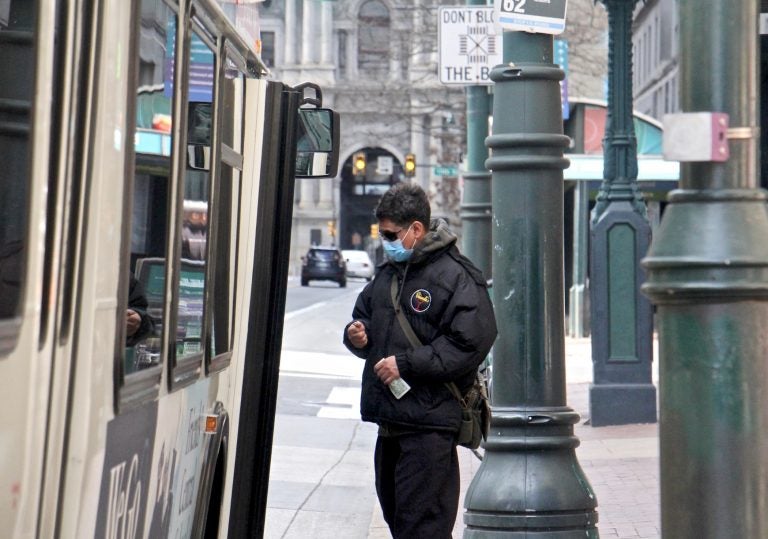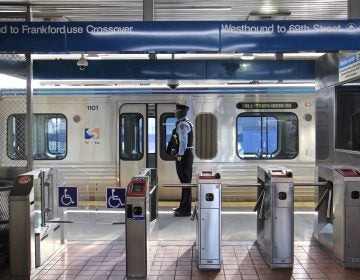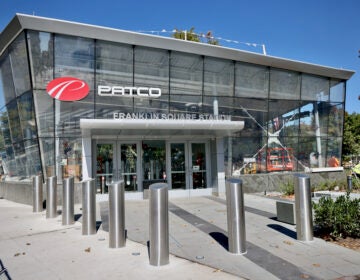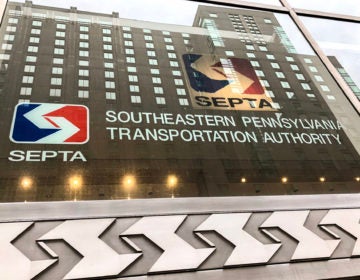‘We need to adapt’: SEPTA launches $25 million bus system redesign
SEPTA riders may encounter consultants surveying riders about their experiences commuting as soon as Monday.

A passenger boards a SEPTA bus on Market Street near City Hall. (Emma Lee/WHYY)
SEPTA is gearing up for a revolution — a Bus Revolution.
The transit authority, Wednesday, launched its long-awaited comprehensive bus network redesign with a name to reflect the grand ambitions of the $25 million overhaul.
“We’re taking a complete blank-slate look at SEPTA’s bus network, making sure that the bus routes are going to the right places at the right time and carrying and operating as efficiently and effectively as possible,” said Bethany Whitaker, project manager and principal at Nelson/Nygaard, the consulting firm contracted to lead SEPTA Forward: Bus Revolution.
The authority will release a web and phone survey on Thursday to begin gathering insight from riders to inform the three-year overhaul of its bus network. It’s likely some riders will encounter consultants asking about their experience commuting as early as Monday. SEPTA signed a $3 million contract with Nelson/Nygaard for the plan last December.
“I think one of the really important things for us to do is to get to know Philadelphia really well,” said Geoff Slater, another principal at Nelson/Nygaard’s Boston office. “I think if you try to ask us questions, detailed questions about Philadelphia today, you can probably trip us up a lot. But six months from now, we hope that you wouldn’t be able to trip us up.”
The first year of the three-year project will be dedicated to gathering data, evaluating transit needs, analyzing individual bus routes, and engaging the public. After that, the plan is to develop options for service improvements, gather public input, and issue a final set of recommendations. Implementation is expected to take place in the third year of the project.
SEPTA’s legacy transit infrastructure goes back more than a century, long before its own beginnings in 1963. The fairly new transportation authority purchased its city transit division in 1968 from then-owner Philadelphia Transportation Company, reportedly the world’s largest privately-owned transit system at the time.
Since then, changes in neighborhood race and class dynamics, work schedules, and even technology have changed the city, creating a mismatch between the routes and riders’ needs. The comprehensive redesign project promises changes to bring SEPTA up to speed.
A 2018 study included suggestions such as eliminating duplicative route segments, wider distances between stops to quicken rides, all-door boarding, focused service on transportation centers, and elimination of the transfer fee. Many of the recommendations aim to speed up bus service.
Initially, SEPTA sought to address sagging bus ridership and competition with ride-hailing services, but the COVID-19 pandemic has introduced a whole new set of challenges as more would-be commuters work from home and many remain reluctant to return to the service.
Officials report that the authority loses about $1 million per day at the farebox. For months, SEPTA reports had transit ridership at 35% of pre-pandemic levels, but last month that number inched up to 38%.
“Ridership has started to rebuild,” Whitaker said. “Through that process, we are learning a lot, including who needs the bus the most, who the reliable riders are when they’re traveling, where they need to go. That is really the road map to the core of the network.”
The pandemic also brought new travel patterns and more attention to racial justice has highlighted the importance of an equitable network, the Nelson/Nygaard planner said.
“I think we tended to have a little bit of a one-size-fits-all approach to transit service planning,” Whitaker said, noting the mistakes of the past. As more people find work in service industry jobs and the nature of work shifts, transit needs to shift too, she said, pointing to increased demand for service on Saturdays.
“We need to respond and adjust and adapt to that,” she said
Slater said the firm is likely to recommend permanent changes to peak service to provide more service during the midday, weekends, and evenings and “a greater focus on the non-work trips.”
Pending approval from the board in June, the bus network redesign will guide the $25 million capital investment in bus infrastructure. The authority plans to make improvements that include right-of-way enhancements, bus wayfinding, end of line bus facilities, and enhanced stops.
The authority also plans to purchase 220 new buses between FY2022 and FY2024. The goal is to retire the last of its diesel fleet and is looking to move toward a zero-emission fleet with battery-electric buses.
The authority rolled out the buses on select routes in June 2019 then took them out of service in February 2020. The sidelining was due to a defect in the plastic chassis of the vehicles that leads to cracking, according to agency sources.
SEPTA spokesperson Andrew Busch said the buses are still under warranty and the authority has had some “some productive discussions” with the buses’ manufacturer Proterra about “making the fixes that can be made to get them out in service.”
In the meantime, Whitaker said such technology is not much of a factor in the redesign. The current focus is “service planning and understanding the service demands and needs.”
“We’re a little bit less worried about the vehicle technology,” Whitaker said. “But when we circle back and talk about implementation, then we’ll take that into consideration.”

Get daily updates from WHYY News!
WHYY is your source for fact-based, in-depth journalism and information. As a nonprofit organization, we rely on financial support from readers like you. Please give today.







